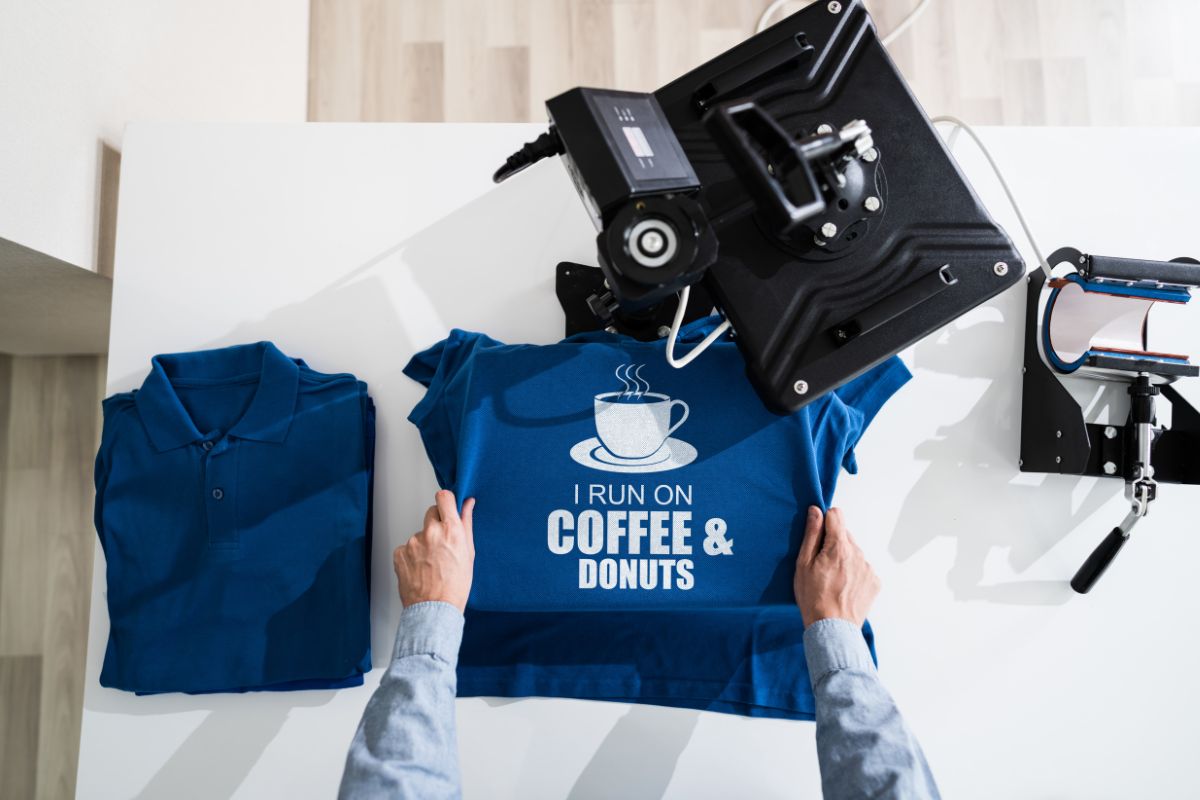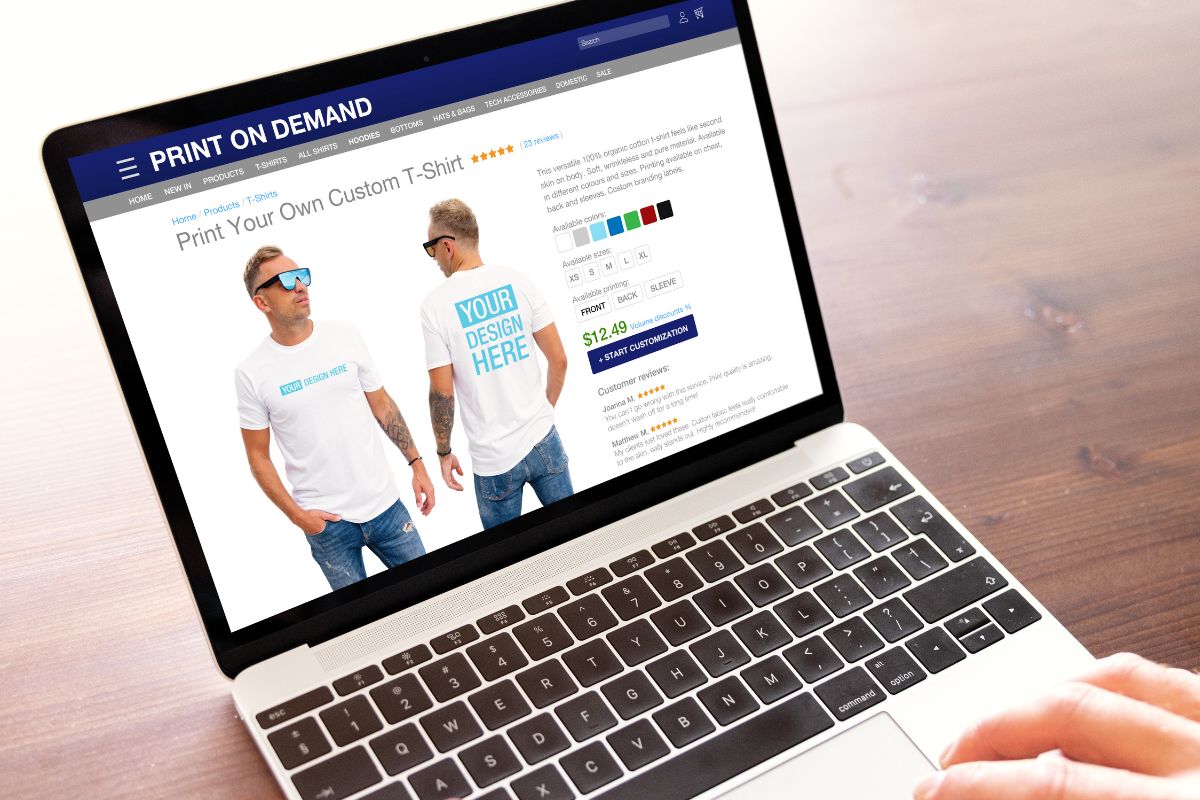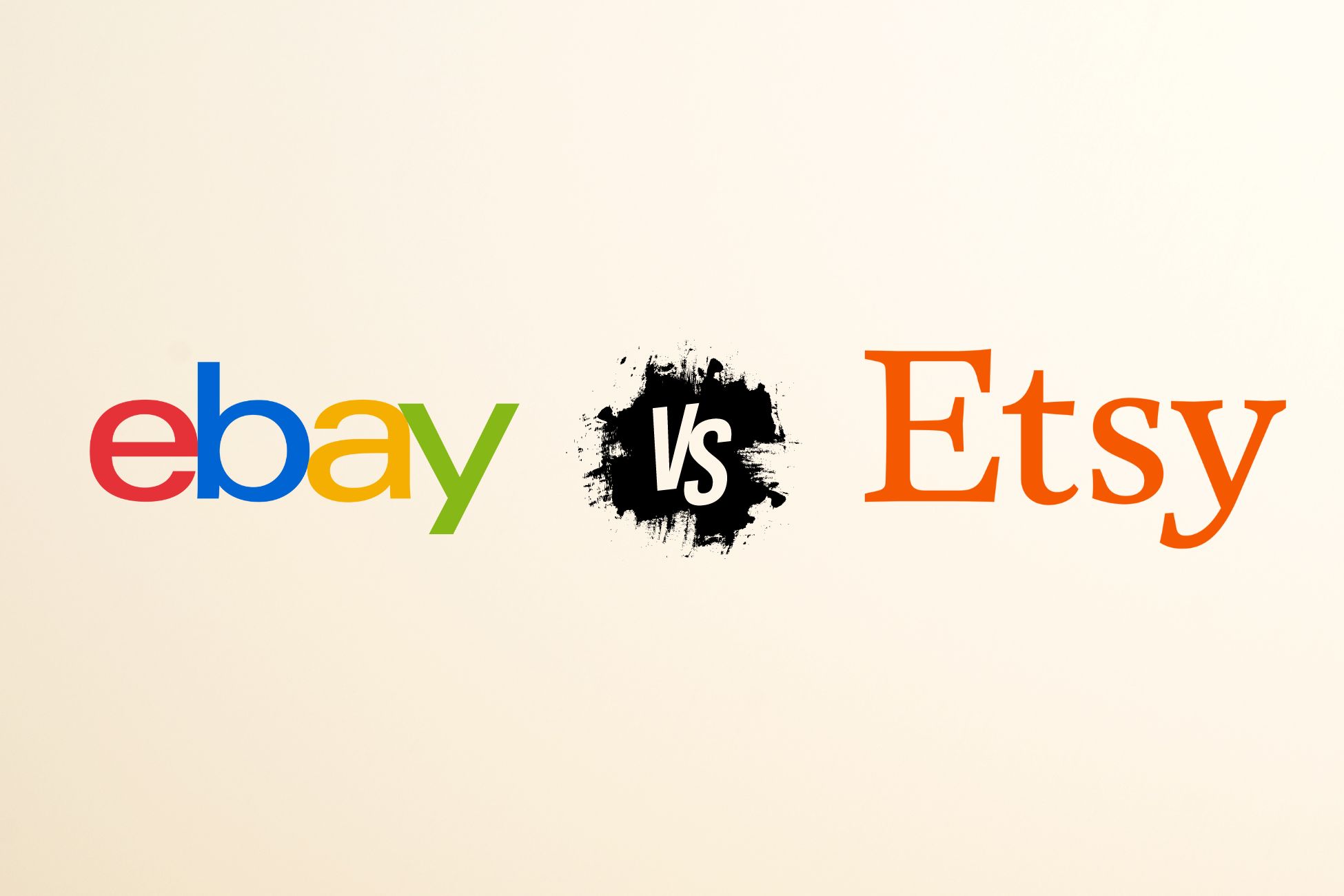Entering the print on demand (POD) business opens up opportunities to sell customized products without the need for inventory, significantly reducing upfront costs. You have the flexibility of offering a wide range of items, from books to apparel, with designs that can be updated at any time, catering to ever-changing customer preferences. As printing technologies have evolved, the ability to efficiently produce single or small quantities of items has become more economically viable. This efficiency aligns well with the growing consumer trend towards personalization and small-batch production.
A POD business model’s profitability hinges on careful strategy and execution. Factors that affect your bottom line include printing costs, platform fees, shipping, and the prices customers are willing to pay for bespoke items. To ensure a profitable venture, it’s important to research the market demands, choose the right products, and develop an effective marketing plan to attract and retain customers. With lower risks compared to traditional retail models, POD offers an accessible path to entrepreneurship.
Success stories in the POD space highlight the potential for lucrative returns. Many entrepreneurs have harnessed predictive and profitable strategies to understand demand and outsmart competitors, indicating that with the right approach, your print on demand business can indeed be profitable. The key is to offer products that stand out, engage with your customers effectively, and optimize your operations for cost savings and efficiency.
Understanding Print on Demand
In exploring the print-on-demand landscape of 2024, you’ll discover a business model that aligns with current e-commerce trends, offering a low-risk entry into the online retail space.
What Is Print on Demand?
Print on demand (POD) is a business process where products are created and shipped only after a sale has been made, effectively keeping inventory costs low. Your involvement is minimal in stocking or handling, as products are printed and shipped by a third-party provider once an order is placed. This model is particularly appealing because it allows for a wide range of custom products, from books to apparel, without the traditional upfront investment in inventory.
The Rise of E-commerce and POD
The intersection of the print-on-demand market with e-commerce platforms has led to a significant shift in how products are sold online. In 2024, leveraging e-commerce platforms, you can market and sell customized products globally with ease. These platforms provide the digital infrastructure that makes POD business more accessible than ever, integrating product creation, sales, and distribution into one seamless process.
Print on Demand Business Model
Your print-on-demand business model is inherently flexible and scalable. The cost structure is primarily variable, meaning you pay for the production of products after your customers place their orders. Key components of a successful POD business include:
- Product Design: Creating or sourcing designs that resonate with your target audience.
- E-commerce Platform: Selecting a platform that supports POD integration and offers a satisfactory user experience.
- Quality and Fulfillment: Partnering with reliable suppliers who provide high-quality printing and timely shipping.
- Marketing: Employing digital marketing strategies to reach and convert your audience.
By understanding each element, you can set up a POD business to operate efficiently, adapt to consumer demands, and capitalize on e-commerce growth.
Preliminary Considerations

Before jumping into a print on demand business, it’s crucial to grasp the foundational elements that can influence your profitability. From understanding market dynamics to pinpointing your specific audience, these steps lay the groundwork for success.
Market Research and Trends
When exploring the viability of a print on demand business, your first step should be comprehensive market research. This means analyzing current market conditions and identifying prevailing trends. Utilize tools like Google Trends to observe search interest patterns and stay abreast of topics that are gaining traction. Look through the lens of market orientation and company performance, and consider how these trends could impact the demand for specific print on demand products.
Identifying Your Target Audience
Understanding who your potential customers are is equally important. Your target audience will have specific demographics, such as age, gender, and income level, as well as particular interests that drive their purchasing decisions. By identifying these characteristics, you can tailor your print on demand offerings to meet their preferences, leading to a higher chance of achieving profitability.
Choosing the Right Niche
Selecting the right niche is about finding the intersection between your interests and what the market demands. It’s essential to choose a niche that isn’t oversaturated yet still has enough customer interest to sustain sales. Balance your personal passion with areas showing promising search queries on Google Trends to find a niche that can be both enjoyable and profit-generating for you.
Setting Up Your POD Business

Setting up a successful Print on Demand (POD) business hinges on choosing the right platform, creating an attractive online store, and selecting unique designs for a diverse product catalog. This foundation enables you to offer custom products that resonate with your target market.
Selecting a POD Platform
When choosing your POD platform, consider industry leaders such as Printify or Printful, renowned for their robust integrations with popular e-commerce platforms like Shopify, Amazon, and Etsy. These services provide a seamless connection between your product designs and the vast customer bases of these online marketplaces.
- Printify: Offers a wide range of products and works on a per-order basis, minimizing upfront costs.
- Printful: Known for its high-quality printing and automatic order fulfillment.
Your selection should factor in the platform’s ease of use, production and shipping times, and the profit margins you can expect.
Creating Your Online Store
Next, focus on setting up your online store to showcase your products. Using a platform like Shopify empowers you with extensive customization options and a user-friendly interface. Your store should be:
- Visually appealing: A clean, professional design that highlights your products.
- Easy to navigate: Intuitive menus and categories that enhance the user experience.
Incorporate key design principles and ensure your site is mobile-responsive, which is essential for capturing the growing number of mobile shoppers.
Design and Product Selection
The core of your POD business lies in the designs and the range of products offered. Start by defining your niche to pinpoint the types of designs and products that will appeal to your specific audience. Consider the following:
- Designs: They should be original and cater to the preferences of your target demographic. High-quality images and descriptions can showcase your custom products effectively.
- Product Range: Diverse options fromclothing to accessories increase the chances of customer purchases. Your product catalog should consist of items that are consistent with your brand.
Consistently refresh your product offerings based on market trends and customer feedback to keep your store dynamic and engaging. Offering the option for customers to order custom products adds a personal touch that can distinguish your brand.
By carefully executing each step, you can establish a robust foundation for your POD business.
Product Creation and Sourcing

In the burgeoning print on demand landscape, your ability to create distinctive designs and manage a reliable sourcing strategy is pivotal to profitability. An effective approach combines unique andcustom designs with intelligent inventory management and solid supplier relationships.
Design Development
Your print on demand business thrives onunique designs that stand out in a crowded market. This starts with establishing a clear design process, perhaps by working with a professional designer or using specialized software to create custom designs. Consistently updating your product catalog with fresh, innovative designs keeps your brand relevant and appealing to customers.
Working with Suppliers
Partnering with the right suppliers is essential for sourcing high-quality products. You should ensure they can reliably produce your designs to a high standard. This might involve negotiating terms that balance cost with quality and ensuring the supplier can scale with your business as it grows. Maintaining a good relationship is crucial, as reliable suppliers are a cornerstone of your product creation strategy.
Inventory Management
Effective inventory management is key to a successful print on demand model because it allows for selling products without the need for physical inventory. You must understand the demand cycles to avoid stockouts or excesses, although your inventory is mostly digital until an order is placed. By ensuring your designs are ready to print and that your suppliers are prepared, you maintain the agility to fulfill orders efficiently and maintain a profitable business.
Pricing and Cost Management

To succeed in a print on demand business, your grasp on pricing and cost management is crucial. It impacts your business’s profitability directly by defining cost structures, setting strategic prices, and understanding profit margins necessary for sustained sales growth.
Cost Structure Analysis
Your cost structure encompasses all the expenses incurred to create and deliver your products. In print on demand, these costs typically include the raw material, printing, packaging, and shipping. By conducting a thorough cost structure analysis, you can identify which costs are fixed, such as the price of the printing press, and which are variable, like shipping fees that fluctuate with distance and weight. This insight allows you to make data-driven decisions on pricing and operational efficiencies.
Pricing Strategy
Determining the right pricing strategy is an art and a science. It requires understanding the market, your competition, and the perceived value of your products. To be competitive, consider the cost and effect of integrating cost systems to drive profitability and performance. Your strategy should not just focus on covering costs but also on setting prices that customers are willing to pay, while still ensuring a healthy profit margin.
Profit Margins and Sales
Understanding and managing your profit margins is essential to your business’s financial health. Profit margin is the percentage of sales that exceeds the cost of goods sold. In the print on demand business, a high volume of sales does not necessarily equate to high profits if your margins are too thin. It’s critical to set prices that not only cover costs but also generate a solid profit, ensuring sustainability and room for growth. Always keep an eye on profitability; it could be the deciding factor between a successful business and one that struggles to stay afloat.
Marketing and Branding

In a print on demand business model, success hinges on your ability to market your products and establish a robust brand identity. Marketing is crucial in driving traffic and converting browsers into buyers, while branding ensures customer loyalty and repeating business.
Building a Brand Identity
Your brand identity is the essence of your business. It’s what distinguishes your print on demand offerings from competitors. Start by defining your brand’s mission, vision, and values. These core principles should resonate throughout your product designs and customer interactions. Remember, consistency across social media, product packaging, and customer service is key in creating a memorable and dependable brand persona.
Implement branding strategies that tell your story. For instance, share behind-the-scenes content, customer testimonials, and user-generated content to foster a community feeling. Encourage your customers to leave reviews and share their product experiences on social platforms. Positive feedback can significantly amplify brand credibility and attract new customers.
Marketing Strategies
When devising your marketing strategies, diversify your tactics. Invest in social media campaigns targeting users who align with your brand’s aesthetic and values. Utilize platforms like Instagram, Facebook, and Pinterest to showcase your products through high-quality visuals and engage with your audience.
Next, consider email marketing to keep your customers informed about new products and special promotions. Leverage this direct line of communication to provide value through relevant content and special offers, encouraging repeat business.
Don’t forget the importance of search engine optimization (SEO) for your online storefront. Optimizing product descriptions, blog content, and meta-information helps your website rank higher in search engine results, increasing organic traffic.
Finally, pay attention to analytics to understand which marketing strategies are working and which aren’t. Adapt your campaigns based on data-driven insights to maximize your return on investment and profitability in the print on demand marketplace.
Sales Channels and Distribution
In the print on demand industry, your profitability hinges on the strategic choice of sales platforms and the optimization of shipping and fulfillment processes. It’s essential to closely evaluate your options and streamline operations to ensure customer satisfaction and cost-effectiveness.
Choosing Sales Platforms
The choice of where to sell your print on demand products can significantly impact your sales revenue. Popular online stores and marketplaces offer robust platforms, but it’s important to consider each one’s audience, fee structure, and integration capabilities with your production process. For a more personalized approach, establishing an e-commerce business through a dedicated website can offer you more control over customer experience but requires effective marketing strategies to drive traffic.
Shipping and Fulfillment
Effective management of shipping and fulfillment is critical to your success. Customers expect affordable and timely shipping options. Negotiate with shipping providers to lower your shipping costs and explore bulk discounts or regional carriers for the best rates. Shipping time greatly affects customer satisfaction, so you’ll want to set realistic expectations and ensure atransparent tracking system. Remember, any delays or damage during shipping can harm your brand’s reputation, so choose reliable logistics partners.
Customer Engagement and Retention

When operating a print on demand business, profitability hinges on your ability to keep customers engaged and returning for more. This not only includes interactions at the point of sale but also how you cultivate relationships post-purchase through exceptional service and the strategic use of customer reviews.
Providing Exceptional Customer Service
To ensure customer retention, your customer service should be second to none. It’s crucial to respond promptly to inquiries and issues, and to do so with a personal touch. You must make customers feel valued at every touchpoint, whether that’s through personalized emails, fast response times, or checking in post-purchase. Remember, excellent customer service often translates to repeat business and word-of-mouth referrals, which are gold in print on demand markets.
Leveraging Customer Reviews
Customer reviews are influential; they can make or break your business’s reputation. Encourage your customers to leave feedback and make it as easy as possible—for instance, by sending a follow-up email with a direct link to the review page. Then, visibly showcase these reviews on your product pages and use them to improve your offerings.
- A positive review can be a powerful tool for convincing potential buyers.
- Constructive criticism helps you refine your products, leading to an overall better customer experience.
By attentively managing customer feedback, you’re demonstrating that you value your customers’ input and are committed to evolving to meet their needs.
Scaling and Expanding Your Business

To capitalize on a print on demand business, your focus should shift to scaling and expansion only after you’ve secured a solid foundation. It’s crucial to analyze business performance and explore strategic expansion methods that foster sustainable growth.
Analyzing Business Performance
Begin by assessing your business’s current health. Examine metrics such as customer acquisition costs, conversion rates, and average order value. These numbers will provide you with critical insights into the profitability and scalability of your e-commerce venture. For instance, a low conversion rate might indicate that your marketing strategies need refinement before you consider expansion.
- Customer Acquisition Costs (CAC)
- Evaluate the efficiency of your marketing spend.
- Conversion Rates
- Measure the effectiveness of your online storefront.
- Average Order Value (AOV)
- Understand the average spending per customer to inform pricing strategies.
Expansion Strategies
Once you understand your business’s performance, you can look into expansion strategies. It’s vital to choose methods that align with your business model and market demand. If your e-commerce platform is experiencing a steady increase in orders, consider adding more products or optimizing your website for international customers. Collaborating with well-known artists or influencers can also be a launchpad for growth through increased brand visibility and trust.
- Product Diversification
- Introduce new designs or product categories.
- Global Market Penetration
- Optimize for cross-border e-commerce to tap into new markets.
- Influencer Partnerships
- Leverage followers of popular personalities for brand growth.
Properly scaling your business requires a balance between maintaining quality and managing increased demand. Keep an eye on your supply chain capability to ensure that you can meet the growth you aim to achieve.
Challenges and Solutions
In the print on demand (POD) business, your profitability hinges on navigating the competitive landscape and staying aligned with consumer preferences. Let’s explore how you can tackle these areas effectively.
Dealing with Competition
Your success in a POD business requires differentiating your offering in a crowded market. Research your competition and identify gaps that you can fill with your unique designs or products. Elevating your brand awareness is crucial, so invest in marketing strategies that make your brand stand out. Consider leveraging social media platforms where visual appeal can attract customers, and create a loyal customer base with engaging content and exceptional customer service.
Adapting to Changing Trends
Trend adaptability is key in the fast-paced POD industry. Keep a close watch on what’s trending and be ready to pivot quickly. This means frequently updating your designs and products to match consumer interests. Use analytics tools to understand which items are gaining traction and which are waning. By staying current, you can captivate your audience with products that resonate with the changing tastes and maintain your edge in the market.
Future of Print on Demand

The print on demand market is continually evolving, with new technologies and consumer trends shaping its trajectory. Your understanding of these developments is crucial to gauge the profitability and longevity of a business in this industry.
Emerging Trends and Technologies
Technology Integration: As you step into the future, stay aware of howadvanced digital printing technologies are revolutionizing print on demand (POD). These innovations are making printing faster, more cost-effective, and higher quality, which could increase your profit margins.
Personalization: Consumers are increasingly seekingpersonalized products. This demand propelsPOD businesses to offerbespoke customizations that cater to individual preferences, making ventures more attractive and potentially more profitable.
Sustainability: The rise of eco-consciousness leads to a trend toward environmentally friendly printing materials and processes. Adopting sustainable practices not only benefits the planet but can also be a unique selling proposition for your POD business.
E-commerce Integration: POD is aligning closely with e-commerce platforms, allowing seamless integration that facilitates easy online sales. This trend is expected to grow, offering a wider market reach and reducing the barriers to entry for new businesses.
By keeping abreast of these trends and integrating them into your operations, you can position your POD business for a secure and profitable future.
Conclusion
Print on demand (POD) businesses offer a unique model where products are printed and shipped only when an order is placed, keeping inventory costs low. Your profitability in a POD business hinges on several key factors:
- Product Niche: Selecting a niche with high demand and low competition can lead to better profit margins.
- Supplier Relationships: Building a strong relationship with a reliable supplier can ensure cost-effective production and high-quality products.
- Marketing Strategy: Implementing effective marketing strategies can increase your brand’s visibility and drive sales.
An insightful case study of the Canon inkjet printer business suggests that understanding your product’s profit structure is crucial. In a contracting market, strategies for improving profit, as discussed in Commercial print, can be vital to your business’s success.
Moreover, staying informed about advances, such as the rise of 3D printing, and adapting your business model to incorporate new technologies can give you a competitive edge.
Your due diligence in market research, cost management, and continuous improvement can significantly influence the success of your POD business. Remember, constant reevaluation and strategic planning are key components in maintaining profitability.
Frequently Asked Questions
When considering starting a print on demand business, there are several pertinent points you need to address. These FAQs encapsulate the core concerns regarding profitability, investment, and strategy.
What factors influence the profitability of a print on demand business?
Profitability in a print on demand business hinges on various factors including your chosen niche, printing costs, marketing effectiveness, and order fulfillment efficiency. Optimizing these areas can lead to a more profitable operation.
How do profit margins compare across different print on demand products?
Profit margins can significantly vary between products. Items like custom t-shirts may have lower margins due to higher competition, while niche-specific products or personalized items often command higher margins.
What are the initial investment requirements for starting a print on demand business?
Your initial investment for starting a print on demand business can be relatively low, as you need not stock inventory. Costs typically include website hosting, design software, and marketing spend.
How long does it typically take to become profitable in a print on demand business?
The timeline to profitability varies widely, but with effective branding and marketing, you could start seeing profits within a few months. However, scaling the business significantly can take longer.
What strategies are key to achieving success in the print on demand industry?
Key strategies include selecting profitable niches, creating high-quality designs, employing strategic marketing, and providing excellent customer service. It’s also crucial to continually analyze and adapt to market trends.
How is the print on demand landscape expected to evolve in the near future?
The print on demand market is anticipated to grow, especially with advancements in printing technology and e-commerce. Staying informed about industry trends and consumer preferences will be essential to capitalize on emerging opportunities.



